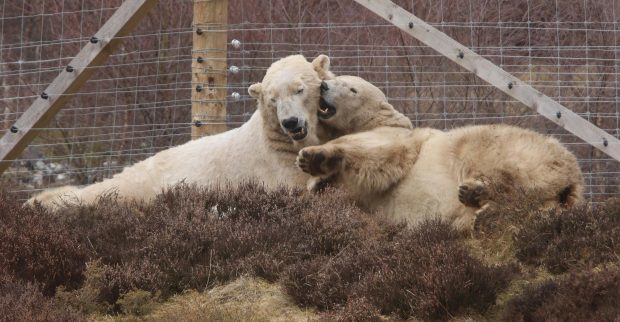Every mother will know how uncomfortable the final days of pregnancy can be – with all that extra weight.
But with the UK’s first polar bear cub in nearly 25 years expected any day, mum-to-be Victoria has put on a staggering 440lb plus in weight.
Staff at the Highland Wildlife Park at Kincraig have kept Victoria well-fed on fish and vegetables as she prepares to give birth.
She is currently out of public viewing because it is believed she is pregnant after mating with Arktos – one of the two male polar bears at the zoo – in the spring.
Polar bears usually give birth to twins, with newborn cubs being around the same size and weight as an adult guinea pig. The last polar bear cub born in the UK was in 1992 at Flamingo Land in Yorkshire.
And the last born in Scotland was on November 15, 1991 when female Ohoto was the second cub to Mercedes at Edinburgh Zoo. Mercedes had previously given birth to male Minty at the zoo in 1988.
There is no pregnancy tests for polar bears but Victoria is showing all the signs of being with cub – including the massive weight gain and regular visits to her her specially built birthing den. The apparent mating success of Victoria is in contrast to Scotland’s pandas.
Female Tian Tian, which means Sweetie, and male Yang Guang, meaning Sunshine arrived at Edinburgh Zoo five years ago but, despite the best efforts of zookeepers, have so far failed to produce a cub.
Vickie Larkin, Head Carnivore Keeper at the Highland Wildlife Park – which like Edinburgh Zoo is run by the Royal Zoological Society of Scotland (RZSS) – said the polar bear breeding window is very short, between one and three weeks.
“We are keeping our fingers crossed, hoping for a positive outcome. Victoria is being monitored very closely and things are pointing in the right direction. She has started to slow down and has put on a lot of weight – some 200 kilos (441 pounds) between April and September!” she said in a blog.
“We would expect a birth to be in December. In the wild, the females go into their snow dens and stay there for up to four months. They don’t go out to feed, which is why they build up their reserves during pregnancy. Polar bears normally have twins, although sometimes one or three cubs are born.”
And the signs are looking good confirmed a spokeswoman for RZSS:”Victoria has been going in and out of her den for the past few weeks, which is consistent with behaviours she has been showing,” she said.
